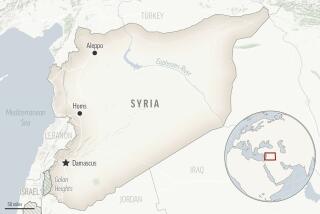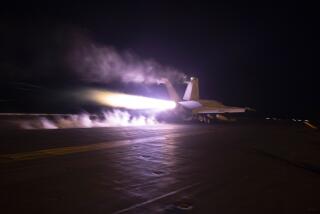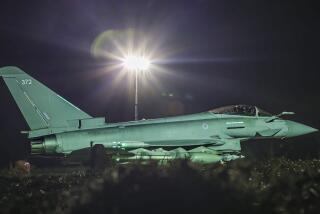U.S., Arab allies struck 24 militant targets in Syria, officials say

The Pentagon says U.S.-led airstrikes in northern Syria targeting Islamic State strongholds “destroyed or damaged” several positions belonging to the militant group.
The deadly Tomahawks roared in from two directions in the predawn hours Tuesday, as the guided-missile destroyer Arleigh Burke in the Red Sea and the cruiser Philippine Sea in the north Persian Gulf fired 47 cruise missiles across the cold desert and into the heart of northern Syria.
Half an hour later, stealthy F-22 Raptors, F-15 Strike Eagles, F-16 Fighting Falcons, supersonic B-1 bombers and unmanned drones swarmed overhead and unleashed scores of precision-guided bombs.
The third and final bombing wave, about three hours later, involved Navy F/A-18 fighter jets from the aircraft carrier George H.W. Bush in the north Persian Gulf and F-16 fighters from regional bases.
By dawn, the carefully choreographed air assault by American and allied Arab air forces against Islamic State and Al Qaeda affiliates had damaged or obliterated 24 distinct targets spread across hundreds of miles, Pentagon officials said, in one of the most dramatic displays of U.S. military might since airstrikes in Libya in 2011.
One bombing run was so precise that a cluster of rooftop communications dishes was destroyed without knocking the building down, Pentagon photos showed. A video showed Navy jets bombing an Islamic State logistics center in a residential area; each munition fell inside the fence line.
Over the last two weeks, White House officials had repeatedly warned that President Obama would not approve an air attack in Syria unless Sunni Arab nations agreed to join the effort to dislodge and ultimately destroy the heavily armed Sunni extremists who have seized control of more than a third of Syria and more than a dozen cities in neighboring Iraq.
Five Sunni Arab governments — Saudi Arabia, the United Arab Emirates, Jordan, Bahrain and Qatar — finally signed on over the weekend and officials said the first four nations flew bombing missions or air patrols. Qatar expressed political support without scrambling fighters.
Their involvement was crucial for the White House, which desperately wanted to avoid accusations it was again intervening in the Middle East in the face of Arab opposition.
“America is proud to stand shoulder to shoulder with these nations,” Obama said Tuesday at the White House before he headed to the annual meeting of the United Nations General Assembly in New York. “The strength of this coalition makes it clear to the world that this is not America’s fight alone.”
Gen. Martin Dempsey, chairman of the Joint Chiefs of Staff, said the first Arab government had agreed to participate “within the last 72 hours” and that the other four governments soon followed. He would not say which country was first.
“Once we had one of them on board, the others followed quickly thereafter,” he said.
The timing proved crucial. Intelligence indicated that Islamic State leaders had begun to discuss moving equipment, fighters and leadership out of training camps in eastern Syria to avoid U.S. bombing, Dempsey said.
The intelligence “was a factor in the decision to strike now before they could make that adaptation,” he said.
Most of the Tomahawks in the first wave slammed into eight targets near Aleppo in northwestern Syria, a stronghold for Al Qaeda-linked Al Nusra Front and the Khorasan Group. U.S. officials said the little-known Khorasan operation was led by seasoned Al Qaeda operatives and was plotting aviation-related attacks in the United States or Europe.
“We know that the Khorasan Group has attempted to recruit Westerners to serve as operatives or to infiltrate back into their homelands,” Lt. Gen. William Mayville, director of operations for the Joint Chiefs of Staff, told reporters at the Pentagon. “The Khorasan Group is clearly not focused on either [Syrian President Bashar Assad’s] regime or the Syrian people. They are establishing roots in Syria in order to advance attacks against the West and the homeland.”
White House officials had made scant reference to the Khorasan Group before Tuesday’s attacks. They indicate that Obama now has broader objectives in Syria, which is engulfed in a civil war, than those he outlined Sept. 10 in a prime-time TV address. Obama then cast America’s intervention as necessary to eliminate the Islamic State group in its strongholds.
The subsequent waves of bombers, fighters and drones hit 16 sites in four other cities in northern and eastern Syria: Raqqah, considered the nerve center and operational base of Islamic State; Dair Alzour, along the Euphrates River; Hasakah, a provincial capital; and Abu Kamal, along the porous border with Iraq. All four towns are Islamic State strongholds.
Syria maintains an extensive network of Soviet-era radar and air defense installations, including antiaircraft batteries, but Pentagon officials said the Syrian military did not engage or try to track the U.S. and Arab warplanes entering their airspace. Mayville described the response as “a passive radar” that did not pose a threat.
Jen Psaki, a State Department spokeswoman, said U.S. diplomats had notified Syria’s envoy at the U.N. before the attack and warned his government not to interfere. Obama has called on Assad to step down and Washington has provided aid to rebels fighting to oust his government.
“We warned Syria not to engage U.S. aircraft,” Psaki said. “We did not request the regime’s permission. We did not coordinate our actions with the Syrian government. We did not provide advance notification to the Syrians at a military level or give any indication of our timing on specific targets.”
Initial damage assessments indicated that the bombardment damaged or destroyed militant training camps, weapons and fuel depots, banks they had seized, communications nodes, supply trucks and armored vehicles, and command-and-control centers. Pentagon officials said they did not specifically target individuals.
“We know we hit what we were aiming at,” said a senior administration official who briefed reporters on condition of anonymity. “They’re an adaptive enemy, but we’re an adaptive foe ourselves.”
Although the United States did not seek U.N. authorization for use of force in Syria, the Obama administration asserted Tuesday that the airstrikes were legal under international law. In a letter to the Security Council, U.S. Ambassador Samantha Power argued that the U.S.-led campaign was consistent with the right of collective self-defense.
Under that legal theory, Islamic State militants pose an imminent threat to Iraq, and the government in Baghdad has requested U.S. assistance, so Washington has a right to defend Iraq, even if it requires sending warplanes into a sovereign nation’s territory. The letter also says the Khorasan Group poses a direct terrorist threat to the United States and its allies.
The principle generally applies when a government will not or cannot act against the threat, legal experts say. In her letter, Power argued that Assad’s government has “shown that it cannot or will not confront these safe havens effectively on its own.”
That assertion may be controversial. Assad’s government has offered to coordinate with the U.S. military and its allies to combat Islamic State, which is seeking to topple Assad. But the Obama administration does not recognize Assad’s legitimacy and has vowed not to coordinate on the operation.
Hennigan reported from Washington and Cloud from Zagreb, Croatia. Times staff writers Paul Richter and Kathleen Hennessey at the United Nations, Christi Parsons in Washington and Patrick J. McDonnell in Beirut contributed to this report.
For more coverage of the conflict in Syria and Iraq, follow @cparsons, @wjhen, @mcdneville, @RajaAbdulrahim and @LauraKingLAT
More to Read
Start your day right
Sign up for Essential California for news, features and recommendations from the L.A. Times and beyond in your inbox six days a week.
You may occasionally receive promotional content from the Los Angeles Times.








